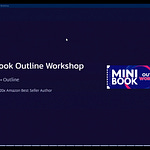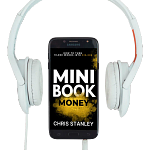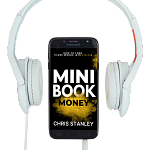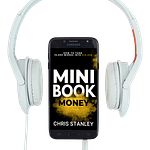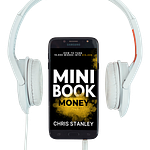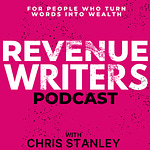NEXT CHAPTER →
Hey Mini Book Masters,
Today I’m releasing chapter 1 from my the upcoming Audiobook, Mini Book Model.
All other audiobook chapters will be reserved for paying members of the Mini Book Newsletter so I wanted to give a free sample so you know if you’d like to experience it or not.
Audiobooks are only one of the benefits and just a tease of what’s to come as I continue to develop the paid side of the Mini Book Newsletter.
My goal for paying members of this newsletter is to make it impossible to not finish your mini book.
Let’s get writing!
What I Mean When I Say “Mini Book”
A new format of writing has arrived.
It arrived out of necessity for readers. The way people consume content is changing, and the creator does not get to decide how people consume content. Authors can only decide if they want to reach those who demand new formats. While legacy non-fiction books remain popular, a shift is happening in our culture, as people demand new and shorter forms of content. The success of TikTok and Twitter reveals that people want content at a faster pace. The writing formats that most writers are familiar with don't satisfy this fast paced craving of readers.
Let's look at the different digital writing formats and how they serve different purposes.
Different Digital Writing Formats
You can tell a reader the same thing in lots of different ways.
You can write a Tweet, blog post, thread, record a video or a podcast. You can host a Zoom meeting to inform a reader of the point you want to make. We can communicate to a reader through so many options and formats, but each serve a unique purpose and has different benefits.
Below are the major forms of digital writing, a quick summation, the average word counts, shelf life, and how long it typically takes to create.
Social Post Quick to write, instant distribution, worldwide audience, short shelf life.
Shelf Life: Short
Time to Write: 1-120 minutes
Word Count: 1-500 words
Blog Post More in depth than a social post and more prep time. No audience except the one you have or search engine visibility you generate.
Shelf Life: Medium
Time to Write: 1 minute to day(s)
Word Count: 250-2500 words
Newsletter Comparable to a blog post in terms of the amount of content, the layout, and the time taken to prepare it. An email newsletter is great because it already has a built-in audience, and it's a direct connection to the reader.
Shelf Life: Short (full inbox)
Time to Write: 1 hour to 1 day
Word Count: 250 – 2500 words
Non-Fiction Book Deeply researched, extreme prep time, audience is at digital and physical bookstores or your website. You can promote on social, blog, and your email list.
Shelf Life: Years to Decades
Time to Write: Months to Years
Word Count: 30,000 – 80,000 words
Ebook Ebooks have been the catch all for digital versions of books, blog posts, and a range of other lengths of material. Any writing that is electronic or "E" has had ebook slapped onto it. Because of this, most readers devalue "ebooks" because it is hard to define the format and can be a gamble for the reader.
Shelf Life: Short to Years
Time to Write: Hours to Years
Word Count: 250-80,000 words
That is the typical hierarchy of digitally written content.
The last format, ebooks, is a moving target. But did you notice a gigantic leap in the word count? We went from 2500 words for a newsletter and blog post to 30,000 words for a non-fiction book. As an author, this gap always frustrated me.
I had more to say than a blog post, but 30,000 words is a lot to ask someone to read or for an author to write on a subject.
I knew historically there had been shorter non-fiction books that have greatly benefited society.
Thomas Paine’s Common Sense was only 20,000 words and helped spark the American Revolution. The wisest man that lived, Solomon, wrote his masterpiece, Proverbs, in 15,000 words. Napoleon Hill wrote a booklet titled Magic Ladder of Success in 1921. In that smaller work, he revealed for the first time his framework that eventually led to his book masterpiece, Think and Grow Rich. Yet, we as authors hold ourselves to a word count of 30,000 for non-fiction books.
Why is that?
Because traditionally published books needed to look fat on a shelf to make readers feel it was worth purchasing. With readers consuming books digitally and craving quick media, it's time to rethink our word counts and to give ourselves permission to write shorter books and give readers the opportunity to read them.
It's time for the era of the mini book.
How is a Mini Book Different?
A mini book is highly consumable fast paced book that makes good on the promise to the reader with no fluff.
The most obvious difference between a legacy non-fiction book and mini book is word count.
Mini books unshackle the author and allow them to write a published book with 5000 words or more. The authors leading the charge on mini books, Category Pirates, typically write between 5000 and 10,000 word count for their works. Mini book is the format that is filling the gap between newsletters/blog posts and legacy non-fiction books.
There are other differences with mini books as well.
Because of the restriction, or liberation in word count, the topic being written about must fit the container you are trying to put your ideas into.
Mini books have 1 interesting topic, question, or idea that dominates the pages. While a legacy non-fiction book may tell you "How to Be an Accountant” and everything that it entails. A mini book would pick up and analyze just one aspect of being an accountant. The topic idea might be, “How to Organize Your Desk as an Accountant”, or “Quit Using QuickBooks: Why It's Ruining Your Accounting Business”.
Mini books are a singular idea versus a slew of ideas.
You might think to yourself, “I've read lots of non-fiction books that only had one idea stretched across the pages.”
Exactly, but those books should have been mini books or blog posts. The author expanded the word count to fulfill the contract with the publisher. Most readers don't make it all the way through those books. 60% or more of books that are started don't get finished.
I'd argue that it isn't because the author's topic, ideas, or words weren't interesting, but because it just took too long for the reader to finish and receive the promised payoff.
We've all read a book where we got the gist of the entire book 1/4 of the way through, in 10,000 words or less and quit reading, that is why I believe mini books are here to stay.
A Mini Book is Your POV
A mini book is perfect for representing an author's point of view.
Your point of view (POV) is what will carry the mini book and the reader to completion. The best mini books have one clear point of view,
Don't use QuickBooks
Your Personal Brand Isn't Helping Anyone
Category Design is the Key to Growing Your Business
Etc.
While most legacy non-fiction books try to cover everything there is to cover on a topic just to fill the page count, a mini book sticks to the POV at which they wrote it from and doesn't chase bunny trails.
Mini books are quick and concise.
Authors fill Mini books with hooks, punches, and finishing lines that leave the reader desperate for more. It's a more entertaining form of non-fiction book writing, which also makes it more challenging for the author than a matter-of-fact blog post. The brevity and singular focus forces the author to abandon long prose and drawn out stories.
Now that you know what a mini book is, let's look at why you need to write one.






